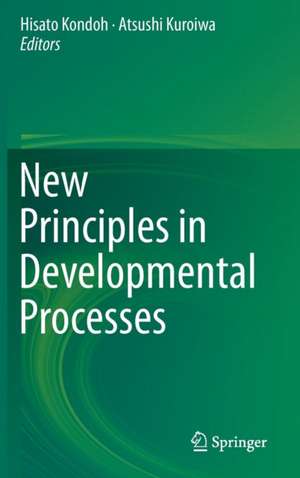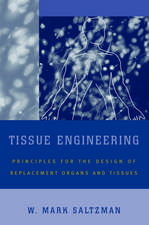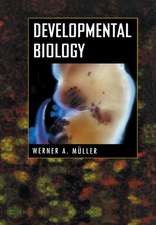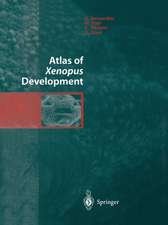New Principles in Developmental Processes
Editat de Hisato Kondoh, Atsushi Kuroiwaen Limba Engleză Hardback – 24 mar 2014
| Toate formatele și edițiile | Preț | Express |
|---|---|---|
| Paperback (1) | 787.61 lei 38-44 zile | |
| Springer – 23 aug 2016 | 787.61 lei 38-44 zile | |
| Hardback (1) | 957.62 lei 6-8 săpt. | |
| Springer – 24 mar 2014 | 957.62 lei 6-8 săpt. |
Preț: 957.62 lei
Preț vechi: 1167.83 lei
-18% Nou
Puncte Express: 1436
Preț estimativ în valută:
183.24€ • 199.67$ • 154.41£
183.24€ • 199.67$ • 154.41£
Carte tipărită la comandă
Livrare economică 23 aprilie-07 mai
Preluare comenzi: 021 569.72.76
Specificații
ISBN-13: 9784431546337
ISBN-10: 4431546332
Pagini: 332
Ilustrații: IX, 321 p. 114 illus., 102 illus. in color.
Dimensiuni: 155 x 235 x 23 mm
Greutate: 0.79 kg
Ediția:2014
Editura: Springer
Colecția Springer
Locul publicării:Tokyo, Japan
ISBN-10: 4431546332
Pagini: 332
Ilustrații: IX, 321 p. 114 illus., 102 illus. in color.
Dimensiuni: 155 x 235 x 23 mm
Greutate: 0.79 kg
Ediția:2014
Editura: Springer
Colecția Springer
Locul publicării:Tokyo, Japan
Public țintă
ResearchCuprins
Part I Making cells unequal in a tissue to form embryos and organs.- Chapter 1 Taxon-specific maternal factors for germline specification.- Chapter 2 Establishment of Anterior-Posterior axis in the mouse embryo.- Chapter 3 Cell competition: the struggle for existence in multicellular communities.- Chapter 4 Building functional internal organs from a naïve endodermal sheet.- Part II Choosing a fate from multiple potencies.- Chapter 5 Determination of stem cell fate in planarian regeneration.- Chapter 6 Regulation of axial stem cells deriving neural and mesodermal tissues during posterior axial elongation.- Chapter 7 Tbx1/Ripply3/retinoic acid signal network that regulate pharyngeal arch development.- Part III Cells in a community of reorganizing tissues.- Chapter 8 Interaction of epithelial cells and basement membrane in the regulation of EMT exemplified in chicken embryo gastrulation.- Chapter 9 Making the Neural Plate to Fold into a Tube.- Chapter 10 Contribution of apoptosis in the cranial neural tube closure indicated by mouse embryo live imaging.- Part IV Heterologous tissue interactions to generate a function.- Chapter 11 Secondary Smad1/5/8-dependent signaling downstream of SHH determines digit identity.- Chapter 12 Deciphering cerebellar neural circuitry involved in higher order functions using zebrafish model.- Chapter 13 Primitive erythroblast cell autonomously regulates the timing of blood circulation onset via a control of adherence to endothelium.- Chapter 14 Limb regeneration: Reconstitution of complex organs using specific tissue interactions.- Part V New players in signaling systems.- Chapter 15 Context-dependent bidirectional modulation of Wnt/β-catenin signaling.- Chapter 16 The role of Tsukushi as an extracellular signaling coordinator.- Chapter 17 Divergent roles of heparan sulfate in regulation of FGF signaling during mammalian embryogenesis.- Chapter 18 Cooperation of signaling for tissue interaction and Hox genes in tissue precursorpatterning.- Part VI Evolutional variations stemming from common principles.- Chapter 19 Molecular and cellular bases of sexual flexibility in vertebrates.- Chapter 20 Differential use of paralogous genes via evolution of cis-regulatory elements for divergent expression specificities.- Chapter 21 Fins and Limbs: emergence of morphological differences.- Chapter 22 The turtle evolution - a conundrum in vertebrate Evo-Devo
Notă biografică
Hisato Kondoh (PhD. Professor, Graduate School of Frontier Biosciences, Osaka University) Atsushi Kuroiwa (PhD. Professor, Graduate School Science, Nagoya University)
Textul de pe ultima copertă
This book highlights representatives of emerging new principles in the developmental biology field, such as cell competition, tissue asymmetry, a farewell to classical germ layer theory, and various new insights into tissue morphogenesis and specification based on the most modern experimental approaches. A large-scale paradigm shift occurred in the last decade owing to innovations in powerful live imaging technologies, gene manipulation techniques in developing embryos, and in-depth understanding of signaling systems, among other advances. Comparison between different animal species also highlighted commonalities of underlying principles, which had not been previously recognized. This book represents important elements that caused that paradigm shift, showing typical examples of phenomena or experimental evidence. It has as its mission the highlighting of important problems that currently are being solved, that are yet to be solved, and that are even still emerging. In other words, this book looks to the future based on the most up-to-date knowledge.
The authors take an energetic, fresh approach to opening up new horizons, and their work here represents the leading edge of contemporary developmental studies of international repute. Readers—both students and established scientists in the biomedical field—will learn where we are, where the problems are, and which way to go in their understanding of the developmental processes. Stem cell sciences need a solid grounding in real developmental processes. The new principles presented in this book provide important suggestions for designing three-dimensional functional organs in vitro and in other forms, and thus will contribute significantly to the future of stem cell sciences and regenerative medicine.
The authors take an energetic, fresh approach to opening up new horizons, and their work here represents the leading edge of contemporary developmental studies of international repute. Readers—both students and established scientists in the biomedical field—will learn where we are, where the problems are, and which way to go in their understanding of the developmental processes. Stem cell sciences need a solid grounding in real developmental processes. The new principles presented in this book provide important suggestions for designing three-dimensional functional organs in vitro and in other forms, and thus will contribute significantly to the future of stem cell sciences and regenerative medicine.
Caracteristici
Unique state-of-the-art discussion of developmental principles Deliberately chosen topics clearly emphasize the new principles in developmental processes Authored by new generation of developmental biologists Includes supplementary material: sn.pub/extras



























